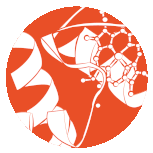
Peeking in the designer’s toolbox
 I am amazed by what our designers can do. I copy-edit a document and send it to Talk Science to Me designers Mari Chijiiwa or Jeff Werner as a Word file, just blocks of black and white text for pages on end. Then they work their alchemical magic and return it as a beautiful PDF file, with colours, images, graphics, pull quotes and stylized headings.
I am amazed by what our designers can do. I copy-edit a document and send it to Talk Science to Me designers Mari Chijiiwa or Jeff Werner as a Word file, just blocks of black and white text for pages on end. Then they work their alchemical magic and return it as a beautiful PDF file, with colours, images, graphics, pull quotes and stylized headings.
Until recently, I’ve only had a vague idea of what Mari and Jeff actually do, but back in July I attended a two-day InDesign workshop through the SFU Publishing Workshops. The workshop was excellent, and I learned a lot of technical skills, but most valuable—and something I hadn’t expected—was the new appreciation I now have for my team members’ tools.
I’ve always considered the Adobe Creative Suite to be someone else’s tools: valuable and powerful, but not mine to concern myself with. At Talk Science to Me, we all—writers, editors, designers—work closely with each other on documents, but we don’t work physically side by side, and this makes it especially easy to be unaware of how others do their jobs. Not understanding your colleagues’ tools is a detriment, and learning even the basics of them is invaluable for a team.
Knowing what designers are able to do means I can ask for more specific things. For example, one thing that proofreaders look for is hyphen “ladders”: stacks of word breaks that pile up on each other and just simply don’t look good. Checking these is a painstaking process that requires a ruler, great eyes and a lot of time. The first two we have in spades, but it’s the third one that always causes grief. At the workshop I learned that InDesign allows you to place a parameter on how many word breaks you’re okay with having in a row, and will automatically adjust the text accordingly. Including that request in your instructions to a designer can save hours of time for everyone.
Not only do I know what I can ask for, but I’m better at asking for it. Before I really understood InDesign, my notes to designers were often vague and roundabout: how could I clearly ask for what I needed when I didn’t know what was possible do to? This improved communication makes me a better proofreader and, ultimately, a better team member.
Understanding what your team members do and how they do it is a matter of respect. To a non-expert, a designer’s work might seem like magic, but the truth is that designers are not working any magic behind the scenes. They don’t deal in tricks or illusions or sleight of hand. They spend hours with tools that they’ve taken the time to master, and they apply expertise that’s been cultivated for years. They’re not magicians: they’re talented designers.
There’s no reason to become expert at using your colleagues’ tools; differentiated expertise is what makes a great team. But taking a peek inside your colleagues’ tool boxes is well worth the time it takes. It’s professional development, team-building and workflow improvement all in one—and that’s magical.

No Comments